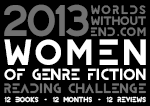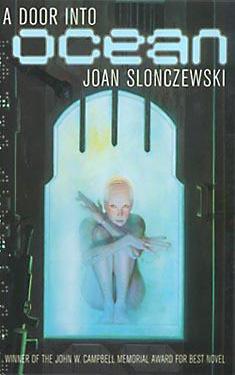WoGF Review: A Door Into Ocean by Joan Slonczewski
 Rae McCausland (ParallelWorlds) was raised on speculative fiction and dedicated most of her teenage years to the dream of writing fantasy novels. During her college years, her interests shifted toward science fiction thanks to Star Trek and Isaac Asimov’s robot stories. She writes reviews for Parallel Worlds Magazine as a way of building connections between the perspectives of fellow sci-fi nerds and people of marginalized gender and sexual identities.
Rae McCausland (ParallelWorlds) was raised on speculative fiction and dedicated most of her teenage years to the dream of writing fantasy novels. During her college years, her interests shifted toward science fiction thanks to Star Trek and Isaac Asimov’s robot stories. She writes reviews for Parallel Worlds Magazine as a way of building connections between the perspectives of fellow sci-fi nerds and people of marginalized gender and sexual identities.
 Intended Audience: Adult
Intended Audience: Adult
Sexual content: Significant
Ace/Genderqueer characters: Yes (Human and Alien)
Rating: PG-13/R for violence, torture, brief sexuality and rape
Writing style: 3/5
Likable characters: 4/5
Plot/Concepts: 4/5
Travelers from the ocean moon of Shora, Sharers Merwen and Usha must judge whether the Valans who have invaded their home are human in any sense they can know. Spinel the stonecutter’s son follows them back, a “malefreak” among an all-female species. In the midst of the rising threat of colonization and extermination, the question remains–can a Valan share sisterhood with the people of Shora, and thus be healed from fear?
I was drawn to this book mainly for its feminist and genderqueer elements. The Sharers—being an all-female race which does not reproduce sexually—cannot really be restricted by the label of “woman” and therefore gender becomes relatively meaningless in their society. At first I was a little annoyed that Spinel, a man, seemed to be such a main character, but I quickly learned that there was no single main character, and I also grew to like Spinel for the way he so easily abandons any sense of masculine superiority. He comes to see himself as a sister to the Sharers, and they accept him as such despite his physical differences. He has moments of feeling like an outsider in both of his families, but that is to be expected with anyone who crosses between worlds.
As the story went on I realized that there was a much more problematic question looming on the horizon. Sharers and their experiences with the colonizing Valans run in close parallel to the history of indigenous peoples who have been brutalized and oppressed over recent centuries. In many ways Sharers are romanticized in this book, and romanticizing a people usually only makes them seem more foreign. But I worried even more about whether Spinel would become the equivalent of a white messiah, proving that only a non-Sharer could save Sharers, much as some films and books have a white man saving the Indians from his own people. This kind of narrative dooms the natives to failure and helplessness every time, and belittles the strengths they have always had in their own culture. It sends the message that they are not good enough on their own, even if the invaders are clearly the bad guys.
So does A Door Into Ocean fall prey to this trope? I can’t say a firm yes or no. Aspects of it are definitely present. For example, Spinel is occasionally referred to by the narrator as the Sharer’s only hope, or something like it. He is allowed places other Sharers are not, so that his adopted identity is almost always an asset. He is excepted from most of the brutalities and oppression his sisters face, which gives him some power in certain situations that they do not have. He has great amounts of Valan privilege despite being a pretty unimportant citizen.
However, while I was afraid that this privilege of his would be the deciding force in the battle for Sharer sovereignty and survival, he actually played a fairly limited role. Whatever advantage they gained was due to the shared efforts of the sisters from all over the globe, as well as the cooperation of enemy soldiers who could not abide the atrocities they were ordered to take part in. I feel like this is a fair depiction of what is necessary to truly win a conflict like this. There have to be people on both sides working to curb the desperation that results in violence. While it is obvious that the main villain, Raelgar, is pretty much a racist sexist genocidal maniac, no single person’s power is infinite. While the chain of command stays cohesive for a depressingly long time, it does eventually begin to break down. Meanwhile the Sharers have their own disputes over whether to give up their humanity by allowing themselves to share violence with their colonizers. Spinel takes a long time to fully accept their way of life in that regard—he wants them to do whatever they must in order to avoid suffering, even if it means killing. The way in which each individual character handles the conflict and responds to it internally is one of my favorite aspects of the book.
 I’m sure some people will disagree with me, and find problems with the way the Sharers are depicted as it relates to the portrayal of indigenous peoples. I would be very interested to hear opinions, especially from people with relevant experience. I’m sure I have many blind spots due to my own privilege and there may be some important points I missed.
I’m sure some people will disagree with me, and find problems with the way the Sharers are depicted as it relates to the portrayal of indigenous peoples. I would be very interested to hear opinions, especially from people with relevant experience. I’m sure I have many blind spots due to my own privilege and there may be some important points I missed.
This book was difficult to read in two different ways. Firstly, it was painful to watch the chain of events as it unfolded, knowing what sort of pattern it would take and how many people might suffer or die in the process. So much of this is due to misunderstandings and assumptions made because of different cultural viewpoints, although some if it is also unadulterated greed and racism. A good portion of the book was horribly depressing in the same way my American Indian history classes were. The second reason it was difficult to read is that the writing style is often wordy. There are some big chunks of text and sometimes my mind would glaze over at the sight of so many complex sentences. I also had a hard time at first with all the translations of sharer verbs, such as “lovesharer” and “learnsharing” and such. I found these words a little cheesy at first, even though later I came to appreciate how the language reflects and shapes Sharer psychology.
Despite reproducing asexually, the Sharers are not asexual in general. They participate in sexual acts with their partners/lovesharers, and it seems to be a given that such acts and attractions are an important part of why coupling happens. They are no longer physically designed for “normal” sex with a male, which is part of why the idea of rape by colonists is even more disturbing. The book doesn’t go into detail about any sexual acts, but they are mentioned enough to give an idea. Spinel and a Sharer named Lystra become a couple and at one point must discuss differences in their ability to perform certain sexual acts, but this is restricted to only a few short scenes.
The worldbuilding is pretty extensive, as the author had to develop not only Shora but Spinel’s world and a few others whose citizens make up the invading force. Spinel’s world and its occupying force seem vaguely modeled after a sort of pseudo-modern medievalism, while Shora is a world in which everything lives in a harmonious natural balance. Pretty much everything on Shora is alive—most Sharers had never seen stone until the Valan traders arrived, and as a thing which is not living and never has lived, it disturbs them. They associate it with death, as only those who die go to “land”, that is, the bottom of the ocean. The living dwell on “rafts” which are really great floating webs of plant matter. This is one example of how the author extrapolates the psychology of the people from their surroundings. I also really appreciated that Sharer sciences were validated as being very advanced, and not simply “witch’s magic”. In fact it is the Sharer sciences which the colonizers most fear.
I found the plot a little hard to follow in some parts, due to the political machinations and trying to keep straight all the important figures and their motivations on the colonizing side. Some of that might be due to the incomprehensibility of Realgar’s character, though. I always find it difficult to really grasp how anyone could see themselves as being in the right while dishing out torture and death. The narrative definitely makes an attempt—I know the rationalizations he used, but from my perspective they seemed incredibly weak. Still, this parallels history in a way too. People are still stunned when they learn of what their fellow humans are capable of, and it’s hard to pick apart exactly why certain horrible events of history occurred, even when we have detailed records and hypotheses.
For the most part, the characters were well defined and each had their own unexpected moments of weakness and strength, which really made them “human”. I grew to love and admire so many of the Sharers, as well as Nisi (a non-sharer woman who learned Sharer ways), Spinel, and even a few of the random side characters. The ending was not 100% happily ever after, although it was fairly satisfying and gave me a lot to think about.



















 Full Details
Full Details


1 Comment
Thanks for your review, one of the most thoughtful I’ve seen.
It may be of interest to note that the book was published in 1986–three years before the peaceful revolutions of Eastern Europe (and a generation before Tahrir Square). I was aware of the Solidarity movement in Poland (my father is Polish). I had studied nonviolent resistance through Quaker religion, and through the works of Gene Sharp, whose tactics were later used in Arab Spring. My father received a postcard from Czech friends who read my book during their revolution.
I wrote during grad school for molecular biology. I was very interested in how politics and biology intersect; a lot of politics can be understood through human and animal biology. The Sharer sense of gender was considered very alien in the 80s. Today young people read it and say “pansexual, of course.” It’s hard to imagine how far we’ve come–and yet how far we still have to go.
Sorry, the comment form is closed at this time.